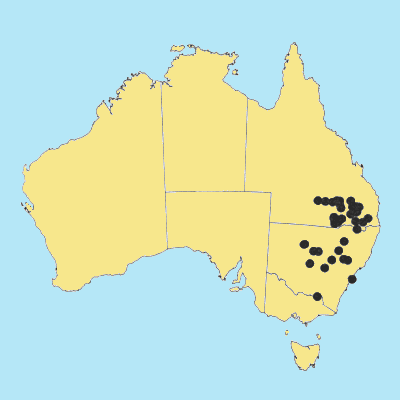Aristida echinata Henrard. Meded.
Rijks. Herb. Leiden 58A :28 s, t.139 (1932), op.cit.54C:713 (1933).
Classification. (GPWG 2001) : Subfamily Aristidoideae. Aristideae.
Type of Basionym or
Protologue Information: LT: W. McComb s.n., Apr. 1918, Queensland:
Warrego Distr,: Morven (K (photo, BRI); IT: BRI). LT designated by Henrard, Meded.
Rijks-Herb. 54(C): 714 (1933).
Recent synonyms:
Aristida ramosa var. scaberula Henrard.
Key references
(books and floras): [1981] M.Lazarides in J.Jessop (ed)., Flora of
Central Australia (451), [2002] D.Sharp & B.K.Simon, AusGrass,
Grasses of Australia, [2008] S.W.L.Jacobs, R.D.B.Walley &
D.J.B.Wheeler, Grasses of New South Wales (128).
Illustrations:
[1983] J.C.Tothill & J.B.Hacker, Grasses of Southern Queensland
(106(29)), [2008] S.W.L.Jacobs, R.D.B.Whalley & D.J.B.Wheeler, Grasses
of New South Wales, 4th edn (128).
Derivation: L. spiny.
Inflorescence a very condensed panicle and the spikelets or auxillary
structures are awned the whole thereby resemble a hedgehog.
Habit.
Perennial. Culms stature robust to moderate, 50–120 cm tall. Mid-culm
internodes glabrous. Lateral branches branched. Leaf-sheaths antrorsely
scabrous, glabrous on surface. Ligule a fringe of hairs, 0.5 mm long.
Leaf-blades straight, flat or conduplicate or involute or convolute, 6–12 cm
long, 1–2.5 mm wide. Leaf-blade surface scabrous.
Inflorescence.
Inflorescence compound, a panicle. Panicle linear, 5–15 cm long, 0.8–2 cm wide.
Spikelets.
Spikelets pedicelled. Fertile spikelets 1-flowered, comprising 1 fertile
floret(s), without rachilla extension, lanceolate, terete, 6.3–10 mm long.
Glumes. Glumes
similar, thinner than fertile lemma. Lower glume lanceolate, membranous,
keeled, 1-keeled, 1 -nerved. Upper glume lanceolate, 4–10 mm long, membranous,
keeled, 1-keeled, 1 -nerved. Upper glume surface scabrous.
Florets.
Fertile lemma 6.3–10 mm long, without keel, 3 -nerved. Lemma apex awned, 3
-awned. Median (principal) awn without a column. Lateral lemma awns present.
Palea without keels. Anthers 3. Grain 5–8 mm long.
Continental
Distribution: Australasia.
Australian
Distribution: Queensland, New South Wales.
Queensland:
Darling Downs, Leichhardt, Maranoa, Moreton, Warrego, Wide Bay. New South
Wales: Central Coast, North-Western Slopes, Central-Western Slopes,
South-Western Slopes, North-Western Plains, South-Western Plains, North Far
Western Plains.
Notes.
A. echinata differs from A. ramosa by the tuberculate surface of
the lemma. It was formerly placed as a variety of A. ramosa (see
comments under that species).
Southern Queensland to
central New South Wales. Acacia, Callitris, blue-grass downs (Dichanthium
spp.), Eucalyptus, and mulga (Acacia aneura) communities on
loams, redearths and sands. Flowering and fruiting August to July.



